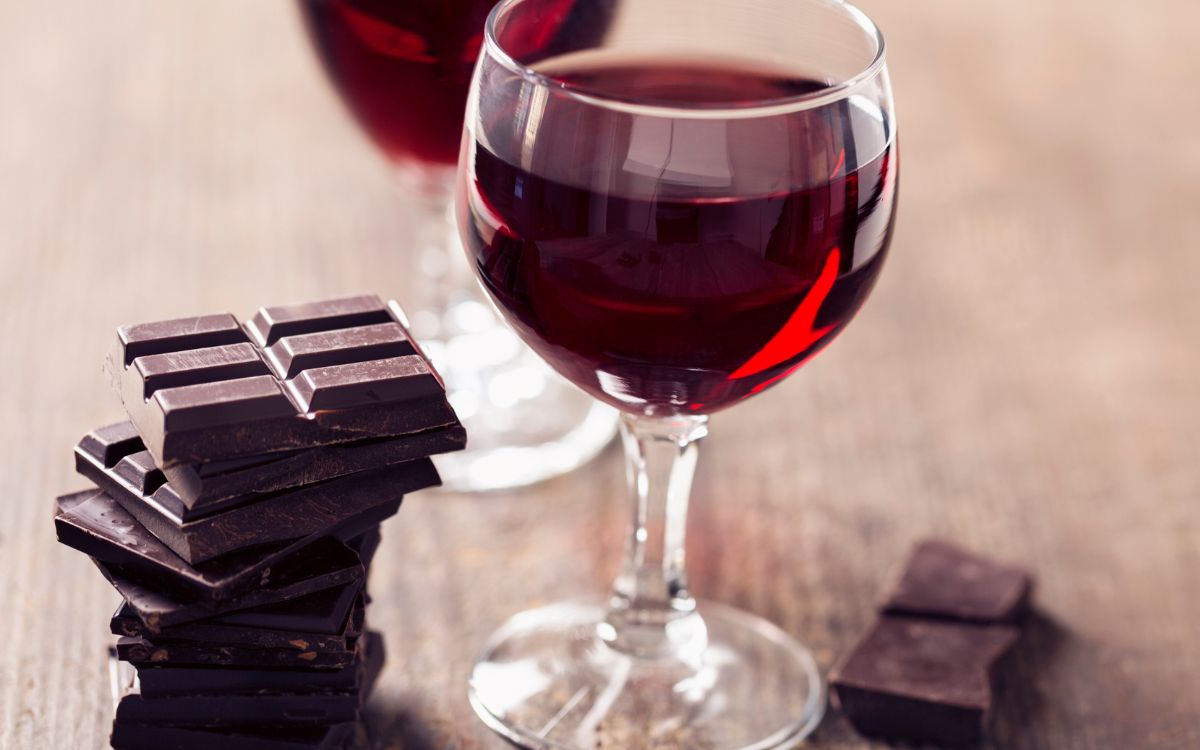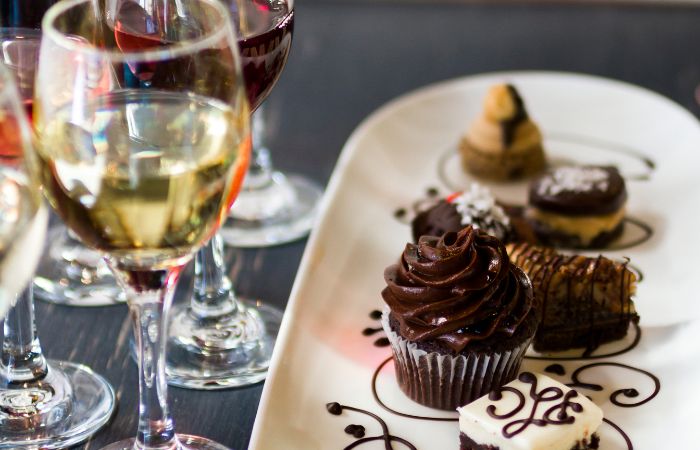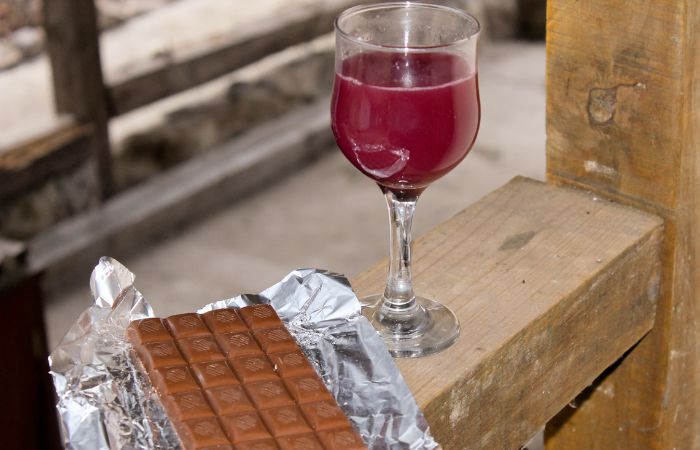Few culinary pairings are as iconic and universally beloved as the combination of these two delectable treats. Whether enjoyed separately or together, chocolate and wine have a unique synergy that delights the senses and elevates the overall tasting experience. But what exactly makes chocolate and wine complement each other so well?

In this post, we will delve into the science and art behind this perfect pairing, exploring the key factors that contribute to their harmonious union. So, grab a glass of your favorite wine, indulge in a piece of chocolate, and join us on this delightful journey to uncover the secrets of this heavenly duo.
The Art of Pairing Chocolate and Wine
Understanding Flavor Profiles
Chocolate, with its diverse range of flavors, presents a variety of options when it comes to pairing with wine. Dark chocolate boasts a bittersweet intensity, while milk chocolate offers creamy sweetness, and white chocolate provides a smooth, buttery experience. On the other hand, wines exhibit their own distinct flavor profiles. Red wines tend to be robust and full-bodied, white wines are crisp and refreshing, and fortified wines offer a complex sweetness.
Finding Complementary Flavors
Pairing chocolate and wine successfully involves finding complementary flavors that enhance and balance each other. One key consideration is matching the sweetness levels of both the chocolate and the wine.
Dark chocolate, with its bitterness, pairs well with bold red wines, whereas milk chocolate harmonizes with dessert wines that have a touch of sweetness. White chocolate, being the mildest in flavor, pairs beautifully with light-bodied wines.
Balancing Acidity and Tannins
Another aspect of pairing chocolate and wine is balancing acidity and tannins. Dark chocolate, with its higher tannin content, can be paired with high tannin red wines, as they complement each other and create a harmonious balance.
Milk chocolate, with its milder flavor profile, can be paired with medium-bodied red or white wines that have moderate acidity. White chocolate pairs well with sparkling wines or dessert wines, as they offer a refreshing contrast.

Exploring Contrasting Textures and Aromas
Beyond the flavors, the contrasting textures and aromas of chocolate and wine can create a delightful sensory experience. Rich, velvety chocolate pairs beautifully with bold, full-bodied wines, creating a luxurious and indulgent combination.
Creamy chocolate complements aromatic white wines, adding a luscious and smooth element to the tasting experience. Crispy or nutty chocolate, with its textural appeal, can be paired with sparkling wines, enhancing the overall sensory experience.
Enhancing the Tasting Experience
Mindful Pairing Techniques
To truly appreciate the harmonious marriage of chocolate and wine, employing mindful pairing techniques can enhance the tasting experience. Start by assessing the intensity of flavors in both the chocolate and the wine. Take a moment to taste the chocolate before sipping the wine, allowing the flavors to unfold on your palate. This approach helps you appreciate the distinct characteristics of each component and how they interact.
Tasting chocolate before sipping wine allows you to savor the nuances of its flavor profile without any external influences. As you move on to the wine, you can detect how it interacts with the lingering taste of the chocolate, noting any complementary or contrasting elements. This mindful sequencing of flavors enhances your ability to fully experience and appreciate the pairing.
Balancing the flavors on the palate is another essential aspect of enhancing the tasting experience. Take small sips of wine and let them coat your palate, allowing the flavors to unfold. Then, take a bite of chocolate and let it melt slowly, covering your taste buds with its richness. Pay attention to how the flavors of the wine and chocolate interact, creating new dimensions of taste and pleasure.
Chocolate and Wine Tasting Parties
Hosting a chocolate and wine pairing event can be a fun and interactive way to explore different combinations and engage with others who share your passion. Select a variety of chocolate and wine options, including dark, milk, and white chocolates, as well as a range of red, white, and fortified wines. Provide tasting notes and encourage participants to discuss their observations and preferences.
Encourage experimentation and discussion among the participants. Allow them to explore their own preferences and experiment with different combinations. This can lead to insightful conversations and discoveries about personal taste preferences and the unique pairings that resonate with each individual. The interactive and social nature of a tasting party adds an element of enjoyment and shared exploration to the experience.
Science Behind the Magic
The Role of Flavanols and Polyphenols
Flavanols, a type of flavonoid compound found in chocolate, and polyphenols, abundant in wine, play significant roles in the pairing’s magic. Flavanols in chocolate are known for their health benefits and antioxidant properties. When combined with the compounds present in wine, they can create unique flavor interactions and enhance the overall tasting experience. Polyphenols in wine contribute to its taste, mouthfeel, and complexity, and their interactions with chocolate flavors add depth and richness to the pairing.
The Influence of Terroir and Production Methods
Terroir, the combination of factors like grape variety, soil, climate, and environmental conditions, influences the characteristics of wine. Different grape varieties and regional variations contribute to the diverse flavors and aromas found in wines.
Similarly, chocolate production involves factors such as bean origins and cocoa varieties, as well as the fermentation, roasting, and conching processes. These variables contribute to the flavor nuances and profiles of chocolate, influencing how it pairs with wine.

Exploring Popular Chocolate and Wine Pairings
Classic Pairings
One classic pairing that never fails to impress is dark chocolate with Cabernet Sauvignon. The bold tannins and fruity notes of the wine complement the rich bitterness of dark chocolate, creating a harmonious balance. Another favorite combination is milk chocolate with Pinot Noir.
The smoothness and creaminess of milk chocolate harmonize beautifully with the fruity and delicate characteristics of Pinot Noir. Lastly, white chocolate pairs wonderfully with Riesling, as its sweetness and subtle flavors complement the light and aromatic qualities of the wine.
Unconventional Pairings
For those seeking unique and adventurous pairings, consider combining dark chocolate with Syrah/Shiraz. The robust and spicy nature of Syrah/Shiraz wines can bring out the complex flavors of dark chocolate, resulting in a delightful contrast. Additionally, try pairing milk chocolate with Champagne.
The effervescence and acidity of Champagne cut through the sweetness of milk chocolate, creating a refreshing and indulgent combination. Lastly, white chocolate can be paired with Sauvignon Blanc, where the wine’s vibrant acidity complements the creamy and buttery flavors of white chocolate.
Beyond Chocolate Bars and Wine Glasses
Desserts and Wine
The pairing of chocolate and wine extends beyond simply enjoying a piece of chocolate with a glass of wine. Indulge in decadent desserts that incorporate chocolate and explore their compatibility with various wine options. For instance, pairing a rich and dense chocolate cake with a bold red wine can create a harmonious balance of flavors.
Consider pairing chocolate mousse with fortified wines like Port or Sherry, as their sweetness complements the velvety texture and intense chocolate flavors. For a white chocolate lover, a luscious white chocolate cheesecake can be beautifully accompanied by dessert wines like Late Harvest Riesling or Moscato.
Savory Dishes and Wine
The enchanting combination of chocolate and wine can also be explored in savory dishes. Incorporating cocoa-infused meat dishes, such as a mole sauce with Mexican cuisine, can create a unique harmony between the earthy, spiced flavors and the complexity of red wines.
The rich, deep flavors of chocolate in savory dishes can pair well with red wines that have sufficient body and tannins. Additionally, consider exploring wine pairings for chocolate and cheese. Combining the creamy, smooth textures of chocolate with the salty or nutty profiles of cheese can be enhanced by a variety of wines, such as Cabernet Sauvignon or Syrah.
Conclusion
In conclusion, the marriage of chocolate and wine is a match made in gastronomic heaven. Their shared qualities of complexity, richness, and depth of flavor create a harmonious symphony for the senses.
The interplay between the smoothness of chocolate and the varying tannins, acidity, and sweetness of wine results in a remarkable tasting experience that transcends the sum of its parts. Whether you prefer a bold and robust red wine with dark chocolate or a delicate white wine with creamy milk chocolate, there is a combination to suit every palate.








